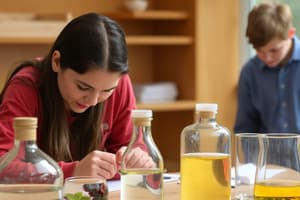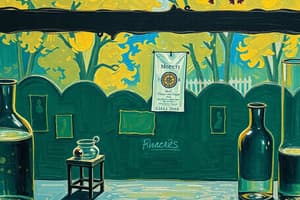Podcast
Questions and Answers
Which of the following properties is a chemical property of a substance?
Which of the following properties is a chemical property of a substance?
- Lustre
- Reactivity with acid (correct)
- Malleability
- Solubility
Ions are formed when atoms gain or lose neutrons.
Ions are formed when atoms gain or lose neutrons.
False (B)
What are the three states of matter?
What are the three states of matter?
Solid, liquid, gas
The periodic table is organized into groups and __________.
The periodic table is organized into groups and __________.
Match the following states of matter with their descriptions:
Match the following states of matter with their descriptions:
Flashcards
Independent Variable
Independent Variable
A variable that is changed or manipulated by the experimenter.
Dependent Variable
Dependent Variable
A variable that is measured or observed in an experiment. Its value depends on the independent variable.
Control Variable
Control Variable
A variable that is kept constant throughout the experiment to ensure that only the independent variable is affecting the dependent variable.
Physical Property
Physical Property
Signup and view all the flashcards
Chemical Property
Chemical Property
Signup and view all the flashcards
Study Notes
Identifying Variables
- Variables are factors that can change in an experiment.
- Independent variables are factors manipulated by the experimenter.
- Dependent variables are factors measured as a result of the changes in the independent variable.
- Control variables are factors kept constant to ensure a fair test.
Qualitative versus Quantitative Observations
- Qualitative observations describe qualities (e.g., color, texture).
- Quantitative observations describe quantities (e.g., mass, volume, temperature).
Physical and Chemical Properties
- Physical properties are characteristics that can be observed or measured without changing the substance's identity.
- Examples include: luster, malleability, solubility, density, melting point, boiling point.
- Chemical properties describe how a substance reacts with other substances or how it changes into a new substance.
- Examples include: reactivity, combustibility, flammability, acidity, basicity.
Classifying Matter
- Pure substance: A substance that has a constant composition throughout.
- Element: A pure substance that cannot be broken down into simpler substances by chemical means.
- Compound: A pure substance formed when two or more elements are chemically combined in a fixed ratio.
- Mixture: A combination of two or more pure substances that are not chemically combined and can be separated by physical means.
- Heterogeneous mixture: A mixture with a non-uniform composition; different parts can be visually distinguished.
- Homogenous mixture (solution): A mixture with a uniform composition throughout; different parts cannot be visually distinguished.
States of Matter
- Solids: Particles are tightly packed in a fixed arrangement.
- Liquids: Particles are close together but can move past each other.
- Gases: Particles are far apart and move randomly.
Atomic Theory
- Atomic theory describes the structure and properties of atoms.
- Experiments like those of Rutherford and Thomson led to our current understanding of the atom.
Atomic Structure
- Atoms have a central nucleus containing protons (positive charge) and neutrons (neutral charge).
- Electrons (negative charge) orbit the nucleus.
- The mass of a proton and neutron is approximately 1 atomic mass unit (amu).
- The mass of an electron is negligible.
- Elements are defined by the number of protons in their nucleus (atomic number).
- The overall charge of an atom is neutral, therefore number of protons equals number of electrons.
Standard Atomic Notation
- Atomic notation represents an element using its symbol, atomic number, and mass number.
Bohr Rutherford Diagrams
- Bohr Rutherford diagrams show the arrangement of electrons in electron shells around the nucleus.
- The rule for filling electron shells is typically 2, 8, 8, 18.
Periodic Table
- The periodic table organizes elements based on their properties and atomic structure.
- Groups (columns) represent elements with similar properties.
- Periods (rows) represent increasing atomic number.
- Metals, nonmetals, and metalloids are located on the table according to their properties.
- Metals are generally on the left side, while nonmetals are on the right.
- Metalloids are along the zig-zag (staircase) line.
-Trends include how properties change as you move across a period or down a group (e.g., increasing reactivity).
- Number of valence electrons matches the group number.
- Valence electrons increase as you move across a period.
Metals and Nonmetals
- Metals are generally good conductors of heat and electricity, shiny, ductile, and malleable.
- Nonmetals are generally poor conductors of heat and electricity, and their properties are often opposite to metals.
Chemical versus Physical Changes
- Physical change alters the form or appearance of a substance but does not change its chemical composition.
- Chemical change alters the chemical composition of a substance, forming entirely new substances.
- Signs of a chemical change: Formation of a precipitate, color change, gas production, heat or light production, odor change.
- Signs of a physical change: Change in state (solid, liquid, gas), dissolving, cutting, bending or shaping.
Chemical Bonding
- Chemical bonding occurs when atoms combine to form molecules or compounds.
- Groups 1 and 17 are generally the most reactive because of their tendency to lose or gain electrons to achieve a stable electron configuration (octet rule).
Ions
- Ions are charged atoms.
- Cations are positively charged ions (lose electrons).
- Anions are negatively charged ions (gain electrons).
Testing for Substances
- There are specific tests to identify various substances (e.g., oxygen, carbon dioxide, hydrogen, water vapor).
Studying That Suits You
Use AI to generate personalized quizzes and flashcards to suit your learning preferences.




